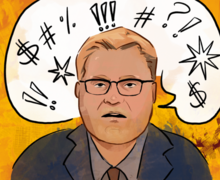Syracuse native Tom Kenny brings SpongeBob voice back to campus
Lars Jendruschewitz | Senior Staff Photographer
Tom Kenny sorts through comic book archives at Syracuse University’s Bird Library. On Tuesday, Kenny visited SU students and discussed his rise to success.
Get the latest Syracuse news delivered right to your inbox.
Subscribe to our newsletter here.
Even as a 6-year-old growing up in East Syracuse, Tom Kenny dreamed of being a “voice-over god.” He worked stand-up and wrote sketch comedy for years, but didn’t perform his first voice-over until he was 30.
“You start to wonder if you’re delusional or crazy, maybe I just suck at this,” Kenny said. “Whatever you want to do in life will kick you in the nards occasionally, and you gotta pick yourself up.”
On Tuesday, Kenny visited Syracuse University’s Whitman School of Management with Paul Kozlowski, a fellow comedian and artist. The two held a panel discussion and Q&A with moderator Oscar Arce, manager of Kenny’s band, Tom Kenny & The Hi-Seas.
Kenny performed his first paid comedy set at Jabberwocky as an SU student in 1979. Jabberwocky closed in 1985 and became Kimmel Hall. Kenny returns as Kimmel is being torn down for new student housing.
Kenny’s a lot like Spongebob. He’s jittery, holding a travel mug of coffee, which Arce had to take away from him during the panel discussion. He’s also childlike, always joking and grinning in front of the crowd.
Kozlowski recalled meeting Kenny in the 1980s outside a comedy club in Boston, where they were both doing stand-up. Kenny was wearing a sailing hat and a coat down to his feet as he ran up and down the street. Kenny joked that usually, if you see a guy like this, you’d cross the street.
As central New York natives, the “machismo” in Boston’s comedy scene made the pair feel like “outsiders.” So they formed a comedy trio with another friend and began working together.
Eventually, Kozlowski created the now-closed FAKE gallery in Los Angeles and the AKE gallery in Cortland, New York. Kenny also pursued his career in the LA comedy scene through Mr. Show with Bob Odenkirk and David Cross, and Rocko’s Modern Life — where he met Rocko’s creative director Steven Hillenberg, who went on to create “SpongeBob SquarePants.”
Kenny mentally goes back in time to the late ‘90s, when a Nickelodeon executive claimed SpongeBob SquarePants would never succeed as a series. Initially, Hillenberg had to “put the show on the line” to have Kenny play the character, Kenny said. Nickelodeon wanted a screen star, like Fred Savage, instead.
Kenny thought Hillenberg did it so Kenny would land the job, but Hillenberg told Kenny it was a selfish decision — he couldn’t envision the character being voiced by anyone else.
“There’s a perceived value on the part of the business in having a recognizable face do it,” Kenny said. “So sometimes you lose out, but sometimes ability actually matters.”
Those words were a comfort to Abigail Shim, an SU sophomore studio arts major. Shim’s end goal is to make a living off her art, whether in character design or another field, and hearing Kenny’s story gave her perspective on the struggles of working in creative industries.
“It was nice to hear someone who has a lot of experience in the entertainment industry talk about struggling and the hardships of getting into the industry,” Shim said. “It lets you know that you can do it, too.”

Lars Jendruschewitz | Senior Staff Photographer
Actor Paul Kozlowski, Tom Kenny and Kenny’s manager, Oscar Arce host a panel at Syracuse University. Kenny spoke to students about his career and life trajectory.
Sonia Issa, an SU graduate student, feels that a critical part of the Spongebob character is his optimism. Though, the older she gets, Squidward’s snarky attitude and disillusionment seems “so real.”
When Issa asked what SpongeBob would do if he were “dropped in the middle of Syracuse” and had to face actual adversity, Kenny joked that Syracuse isn’t the place for Spongebob. He noted that pessimism is easier than optimism, especially with the current political climate.
“Bleakness is always hammering at you. It’s everywhere,” Kenny said.
But Kenny acknowledged that even Spongebob sometimes got somber — his trademark “I’m ready” becomes slumped and disheartened, but never stops. That tenacity has played a positive role in Kenny’s life. Just as he plays the character, the character plays him and benefits his outlook on life.
Voice actors like Kenny and Hank Azaria, who voices more than 100 characters on “The Simpsons,” face the risk of artificial intelligence replacing them. In a recent op-ed to the New York Times, Azaria said he doubted AI would ever replace voice actors, as “bodies and souls are involved to get the proper believability.”
When Shim asked Kenny about AI replacing artists in animation and other fields of art, he admitted he had some fears. But new technology has always threatened animation, and animation has survived through “passion and grit.” Kenny used the advent of computer generated animation as an example.
Kenny’s creative journey hasn’t been consistent. From his first stand-up show to his hundreds of other roles in voice acting, Kenny adapted to new roles and changed industry standards. But that’s fueled him, and he’s figured out new things and roles “on the fly.”
“Then you feel good when you figured it out and nobody died,” Kenny joked. “That’s what excites me. The skydiving continues.”
Published on February 13, 2025 at 2:22 am
Contact Ben: bnbutler@syr.edu






